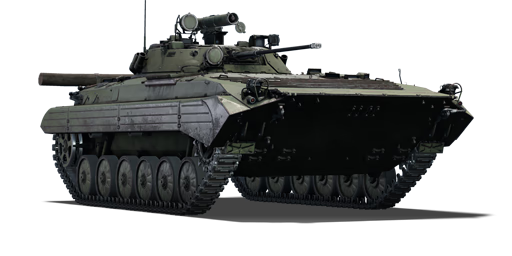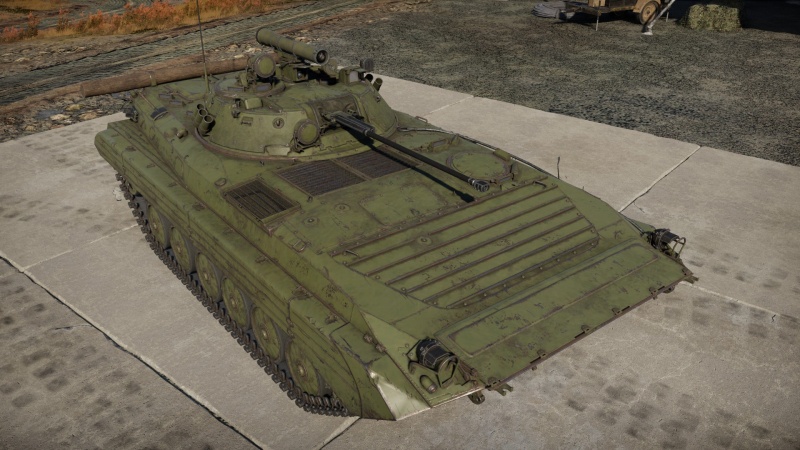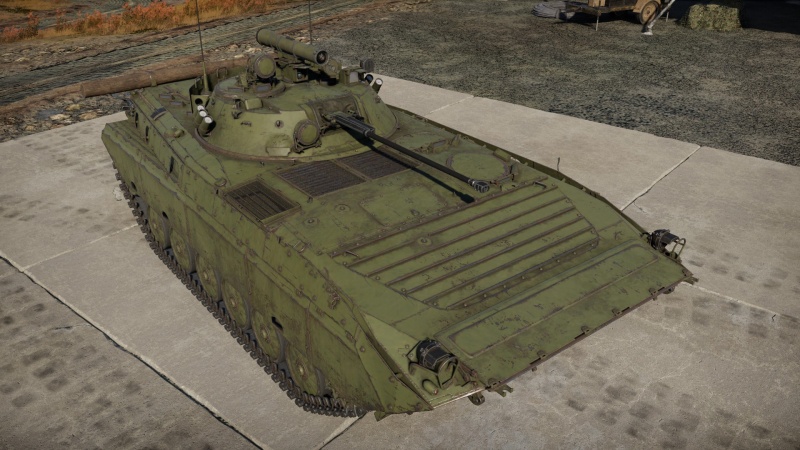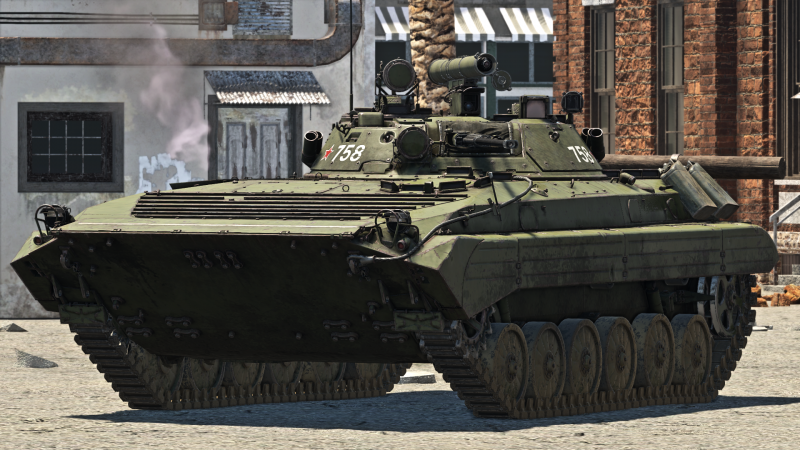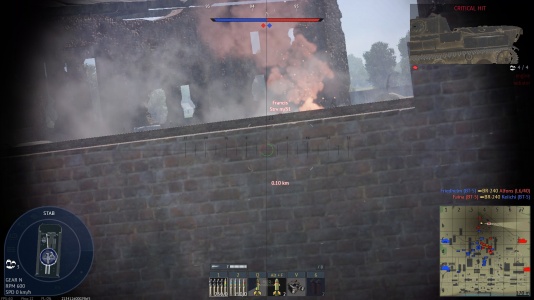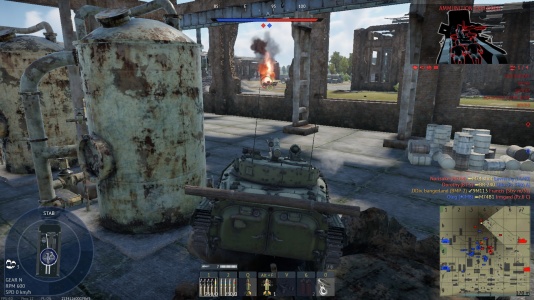BMP-2
| This page is about the Soviet light tank BMP-2. For other uses, see BMP (Disambiguation). |
Contents
Description
The BMP-2 is a Soviet IFV designed with the intent of overcoming the shortcomings of its predecessor, the BMP-1. The BMP-2 was developed in the late 1970s and quickly became one of the most widely used infantry fighting vehicles in the world. It featured improved firepower, enhanced protection, and an improved fire control system compared to the BMP-1. As one of the most versatile IFVs of its time, the BMP-2 was equipped with a 30 mm automatic cannon and anti-tank guided missiles, making it highly effective against both armoured and infantry targets. Its amphibious capabilities further increased its tactical advantage on the battlefield. Several nations adopted the BMP-2 as a result of its success, and subsequent variants like the BMP-2M allowed for a multi-decade service life extension.
The BMP-2 was introduced in Update 1.81 "The Valkyries". Its primary armament is the 30 mm 2A42 autocannon, which can effectively deal with light vehicles, tanks, and even helicopters. Additionally, the BMP-2 is equipped with a launcher capable of firing 9M113 Konkurs ATGMs, making it a potent threat against enemy tanks at range. It is best used as a support vehicle due to its versatility and ability to engage multiple types of targets. However, it does have some limitations, as its armour protection may prove insufficient against calibres larger than 12.7 mm, while its mobility may fall short compared to some peers in its class, which can limit its effectiveness in certain situations. Nonetheless, with proper positioning and teamwork, the BMP-2 can be a valuable asset on the battlefield.
General info
Survivability and armour
Armour type:
| Armour | Front (Slope angle) | Sides | Rear | Roof |
|---|---|---|---|---|
| Hull | 15 mm (57°) | 13 mm (15°), 5 mm (68°) Top 15 mm (0-25°) Bottom |
13 mm (13-64°) 16 mm (17-44°) |
5 mm (66-90°) Rear 8 mm (81°) 7 mm (90°) Hatches 12 mm (81°) 5 mm Engine grille |
| Turret | 30 mm (32°) 25 mm (1-89°) Gun mantlet 20 mm (31-83°) 20 mm (30-82°) |
16 mm (32-26°) 30 mm (18°) Top right 20 mm (30-82°) |
10 mm (21-°) | 6 mm (0-89°) |
| Cupola | 6 mm | |||
Notes:
- 6 mm side skirts added with BMP-2D
- 6 mm armour layer added to the turret side
- 6 mm armour added to hull top sides
- The amphibious ability is lost after the armour modifications are installed
- Tracks and wheels are 10 mm thick
BMP-2:
The BMP-2 armour layout consists of mostly High Hardness Rolled Armour. The front plate and turret armour is sufficient to stop anything short of a small autocannon. The sides are generally resistant to machine gun fire, although larger calibre rounds such as those fired from the 12.7 mm .50 calibre machine guns on many American tanks can penetrate the side and rear of the BMP-2. Depending on where it is hit, the BMP-2 is generally not very survivable due to the low crew count. Having only 3 crew means that if any penetrating round kills 2 of them, you are dead. Some shots might hit empty space, but you should not rely on it. Generally it is best practice to be very careful when driving the BMP-2. Even if you have disabled the enemy vehicle's main cannon, they may still be able to damage you with their heavy machine gun. The BMP-2 is also vulnerable to overpressure, it will be destroyed by large-calibre HE shells and by ATGMs.
BMP-2D:
The BMP-2 has optional add-on armour which improves its resistance to heavy machine gun and some light cannon fire from the sides and rear of the turret, at the cost of losing its amphibious ability. This armour means that you are safe from enemy tanks once you have disabled their main gun. This modification has little effect on the overpressure vulnerability mechanics of the BMP-2.
Mobility
| Game Mode | Max Speed (km/h) | Weight (tons) | Engine power (horsepower) | Power-to-weight ratio (hp/ton) | ||||
|---|---|---|---|---|---|---|---|---|
| Forward | Reverse | Stock | AoA | Stock | Upgraded | Stock | Upgraded | |
| Arcade | 72 | 12 | 13.2 | 0.8 | 465 | 572 | 35.23 | 40.86 |
| Realistic | 65 | 10.5 | 265 | 300 | 20.08 | 21.43 | ||
The BMP-2's mobility is reasonable, albeit not excellent, at a maximum of 72/65 km/h (AB\RB) on-road, however, the vehicle's acceleration and off-road performance leave something to be desired.
The BMP-2 can swim at 7 km/h.
Modifications and economy
Armaments
Main armament
The Shipunov 2A42 30 mm autocannon is a very versatile weapon - it is possible to change its fire rate based on the situation and it has vertical guidance of +74 degrees, which makes it effective not only against tanks but for planes and helicopters as well.
The main concern with this powerful main weapon is the ammo capacity. The gun has two firing modes - relatively slow (~200/minute) and extremely fast (~550/minute), while your ammo capacity is 500. To not run out of ammo during the battle, one should use full auto mode only when facing certain doom, or when sitting in an ambush position against an unknown enemy.
Its reload rate for the belts is quite fast at 1 second and it gets a choice of HEF-T, AP-T, and HVAP in belts. Every belt is universal and has at least 1 AP and 1 HE in them, HE belt carrying 2 of HEF-T for 1 AP-T per cycle.
The HVAP belts have enough penetration to obliterate lighter tanks such as Leopard A1A1s, AMX-30B2 BRENUS and Warrior frontally, however, when engaging other larger targets it's only possible to completely defeat them from the side, though you can still cripple enemy tanks frontally by shooting cannon barrels and tracks.
The main difference of the HVAP compared to the APDS of other autocannon-equipped vehicles is that it is very bad against angled tanks and when attacking tanks on high ground (Refer to the table, to see how bad it can get). Because of that, targets usually easily dealt with such as the Striker may deflect fire from your main gun when heavily angled. When facing something the main gun cannot deal with, you'll need to use the secondary weapon:
| 30 mm 2A42 | Turret rotation speed (°/s) | Reloading rate (seconds) | ||||||||||||
|---|---|---|---|---|---|---|---|---|---|---|---|---|---|---|
| Mode | Capacity (Belt) | Fire rate | Vertical | Horizontal | Stabilizer | Stock | Upgraded | Full | Expert | Aced | Stock | Full | Expert | Aced |
| Arcade | 500 (250) | 550 | -4°/+74° | ±180° | Two-plane | 28.6 | 39.5 | 48.0 | 53.1 | 56.5 | 1.30 | 1.15 | 1.06 | 1.00 |
| Realistic | 17.9 | 21.0 | 25.5 | 28.2 | 30.0 | |||||||||
Ammunition
- Default: AP-T · HEF-I*
- 30 mm HE: HEF-I* · AP-T · HEF-I* · HEF-T*
- 30 mm APT: AP-T · AP-T · AP-T · HEF-T*
- 30 mm APDS: APDS · APDS · APDS · APDS · HEF-T*
| Penetration statistics | |||||||
|---|---|---|---|---|---|---|---|
| Ammunition | Penetration @ 0° Angle of Attack (mm) | ||||||
| 10 m | 100 m | 500 m | 1,000 m | 1,500 m | 2,000 m | ||
| HEF-I* | 8 | 7 | 6 | 5 | 4 | 3 | |
| AP-T | 65 | 63 | 53 | 44 | 36 | 29 | |
| HEF-T* | 9 | 8 | 7 | 5 | 4 | 3 | |
| APDS | 82 | 81 | 79 | 75 | 72 | 69 | |
| Shell details | ||||||||||||
|---|---|---|---|---|---|---|---|---|---|---|---|---|
| Ammunition | Velocity (m/s) |
Projectile mass (kg) |
Fuse delay (m) |
Fuse sensitivity (mm) |
Explosive mass (TNT equivalent) (g) |
Ricochet | ||||||
| 0% | 50% | 100% | ||||||||||
| HEF-I* | 960 | 0.39 | 0.1 | 0.1 | 75.46 | 79° | 80° | 81° | ||||
| AP-T | 970 | 0.4 | - | - | - | 47° | 60° | 65° | ||||
| HEF-T* | 960 | 0.39 | 0.1 | 0.1 | 17.86 | 79° | 80° | 81° | ||||
| APDS | 1,120 | 0.3 | - | - | - | 75° | 78° | 80° | ||||
Ammo racks
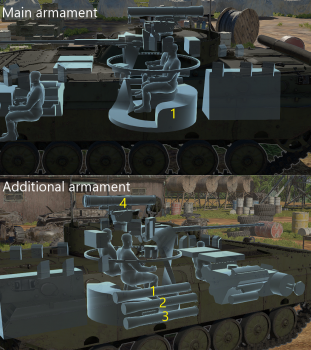
| Full ammo |
1st rack empty |
Visual discrepancy |
|---|---|---|
| 2 | 0 (+2) | No |
Additional armament
BMP-2 also has an ATGM launcher. Its guidance system is semi-automatic, so it's easier to use in RB. It is a default modification on the vehicle, unlike the BMP-1, so doesn't need to be researched.
The ATGM is able to penetrate most tanks BMP-2 will face at its BR and often above when aimed well. The 9M113 is also fairly useable at range, although it generally won't reach sniping helicopters. The BMP only has 4 ATGMs, so it's a good idea to be stringent with them.
Unlike BMP-1, BMP-2 can directly aim with the ATGM launcher by using "select special weapon or ATGM" key, which also disables the main turret. The launcher can turn 15 degrees to the left or 38 degrees to the right. This may seem a bit redundant, as BMP is too short to directly fire over walls, but when the tank is using something as a stepping stone it can lean just enough to be able to see a bit of enemy tanks and to not lose control over the missile anymore. Since the missile is launched a bit up, if the target is about 90-150 m away, then hitting it would just require aiming the crosshair directly at it. Remember to use "reset weapon selection" key to return controls to normal.
| 9M113 Konkurs ATGM | Turret rotation speed (°/s) | Reloading rate (seconds) | |||||||||||
|---|---|---|---|---|---|---|---|---|---|---|---|---|---|
| Mode | Capacity | Vertical | Horizontal | Stabilizer | Stock | Upgraded | Full | Expert | Aced | Stock | Full | Expert | Aced |
| Arcade | 4 | -5°/+15° | -15°/+37° | N/A | 28.6 | 39.5 | 48.0 | 53.1 | 56.5 | N/A | N/A | N/A | N/A |
| Realistic | 17.9 | 21.0 | 25.5 | 28.2 | 30.0 | ||||||||
Ammunition
| Penetration statistics | |||||||
|---|---|---|---|---|---|---|---|
| Ammunition | Type of warhead |
Penetration @ 0° Angle of Attack (mm) | |||||
| 10 m | 100 m | 500 m | 1,000 m | 1,500 m | 2,000 m | ||
| 9M113 | ATGM | 500 | 500 | 500 | 500 | 500 | 500 |
| Missile details | ||||||||||||
|---|---|---|---|---|---|---|---|---|---|---|---|---|
| Ammunition | Type of warhead |
Velocity (m/s) |
Range (m) |
Projectile mass (kg) |
Fuse delay (m) |
Fuse sensitivity (mm) |
Explosive mass (TNT equivalent) (kg) |
Ricochet | ||||
| 0% | 50% | 100% | ||||||||||
| 9M113 | ATGM | 248 | 3,000 | 14.5 | 0.05 | 0.1 | 4.37 | 80° | 82° | 90° | ||
Ammo racks

| Full ammo |
1st rack empty |
2nd rack empty |
3rd rack empty |
4th rack empty |
Visual discrepancy |
|---|---|---|---|---|---|
| 4 | 3 (+1) | 2 (+2) | 1 (+3) | 0 (+4) | No |
Machine guns
7.62 mm PKT is only useful for destroying light obstacles to avoid losing momentum. Alternatively, it can be used to mark the enemy in Realistic battle. Using it for anything else is pointless, as your 30 mm is far more effective otherwise, and the 7.62 mm won't cause damage to anything but early aircraft or open-top vehicles with exposed crew.
| 7.62 mm PKT | ||||
|---|---|---|---|---|
| Mount | Capacity (Belt) | Fire rate | Vertical | Horizontal |
| Coaxial | 2,000 (250) | 700 | N/A | N/A |
Usage in battles
The BMP-2 is best played as a light support vehicle, avoiding being a primary target in the front of the battle.
Where possible, scout opposing vehicles for teammates while staying near heavier friendly vehicles, helping repair and support them as necessary. By staying mostly in cover and near more threatening targets, you'll avoid being a target yourself. The BMP isn't particularly fast for a light tank, but if you can move into a position that enemy tanks will be passing, you'll be able to make quick work of them with the 30 mm gun.
Before the armour modification has been researched, the players can take advantage of the amphibious capacities of the BMP-2 to either infiltrate in the enemy territory to scout or to flank that enemy access and retain the enemy advance; at least for a short time.
As an advance from the BMP-1, the BMP-2 offers a great improvement in combat usage, as there's no need to research the better ATGM armament. Another upgrade in the playstyle is the possibility of close range anti-air duties thanks to the 30 mm Shipunov cannon, particularly to the omnipresent helicopters at this rank, such as the American AH-1G. The cannon is also useful for light and medium ground targets with slightly sloped armour, however, the stock HE performance against armour is poor and the need for the APDS belt will be evident. Therefore the anti-air duties are an essential part of the early playstyle and module research.
ATGM guide
The 9M113 Konkurs ATGM steers rather unpredictably. When fired, the 9M113 drops below your aim reticle in the first 15 metres (due to being at low speed right after launch). After surpassing 15 metres, the ATGM will have accelerated enough to fly up and stabilize itself with your aim reticle. Due to this launch drop, it is suggested to aim slightly up when firing the ATGM: this will avoid having your ATGM hit the ground or any fences as sometimes that tends to happen. When the ATGM is flying, steer it gently and carefully. Instantly snapping at another target can cause it to oscillate from side-to-side and hit something on the way or miss the target entirely.
Anti-air role
The BMP is somewhat vulnerable to aircraft fire, particularly larger cannons will make quick work of the vehicle through its near non-existent top armour. Where possible, find positions with a good overhead cover or minimal visibility for overhead aircraft (beneath over-arching rocks, near or in buildings, under dense tree cover). If for any reason you do become the target of a strafing run, don't be afraid to fire back - the 30 mm will make quick work of most aircraft, and in head-on engagements is particularly easy to get on target.
It is recommended to improve the turret targeting speed with the modifications, as this provides faster target acquisition. The ATGM can also be put in use against any helicopter hovering close to the battlefield, remember the 3 km range when engaging them.
| Tip: The BMP-2 offers the ability to switch the cannon firing rate, useful for saving ammunition or quickly dispatching air targets! |
Close support
The BMP-2 is a light combat vehicle with good offensive power, as such, a recommended combat tactic is to remain near the tougher tank comrades assaulting and capturing points in the core of the action. Not only because of the proficient anti-air capabilities of the BMP-2 or the mighty Konkurs' ability to deal with any heavily armoured targets like the Maus. But also because the BMP-2 can act as a field mechanic for allied tanks along the frontline.
Acting as a team-player also entails using every mean of protection to ensure the teammates' safety, this will be usually achievable thanks to the various smoke discharges available.
Scouting
The BMP-2 is not only capable of fiercely defending itself but is also capable of providing scouted targets for the whole allied team. Becoming the force of change in any assault or defence and a decisive piece in the road for victory.
A single BMP-2 can find a suitable covered position on a hill or a ditch deep enough (like on the Kursk map) and proceed to scout any enemy in the binoculars sight. It doesn't matter if the BMP does not have a gun solution, the purpose is to relay the enemy's position to the team while remaining in secret. This not only helps the teammates on anticipating any threats, but once the airstrike modification has been researched, it also enables the player to jump into any suited aircraft and continue supporting the team.
Pros and cons
Pros:
- Can easily destroy other light vehicles with both its main gun and its ATGM launcher
- At times is surprisingly survivable, the vehicle's internals are largely non-critical components
- Can ford rivers/canals to get to locations that are normally difficult or sometimes impossible to reach
- Somewhat effective as an AA with fast-firing 30 mm
- ATGMs will comfortably destroy almost any vehicle with a well placed missile
- 30 mm HVAP can quickly disable tracks/gun barrel on any target
Cons:
- The 30 mm HVAP is not as powerful as APDS on other AFVs and has extremely bad angled performance
- Small maximum ammo load, can only take a single APDS belt, exactly 160 shells (Changing to low rate of fire is recommended)
- Vulnerable to HMGs and light cannons at close ranges, particularly without add-on armour
- Vulnerable to overpressure (HE shells, bombs, rockets, ATGMs and artillery strikes).
- Konkurs ATGM is highly ineffective against vehicles with ERA like the Sho't Kal Dalet (Great Britain) or the M60A1 RISE (P)
History
Development
After the Yom Kippur War, it became clear that the armament of the BMP-1 was proven to be insufficient, as well as the protection. Egyptian and Syrian BMP-1's had been knocked out by 12.7 mm (.50 in) machine gun fire through the sides and rear. The BMP-1P was developed in order solve some of the problems with the BMP-1, but a new model was needed. Work began on creating an improved version of the BMP-1, called the BMP-2.
Design
The hull of the BMP-2 was nearly identical to the hull of the BMP-1. The armour was unchanged - other than the side armour which could now withstand 12.7 mm machine guns - as was the shape of the hull itself. The turret, on the other hand, was of a new design. It was the same general shape as the turret of the BMP-1, but it was much larger. The commander sat to the right of the gun breech and the gunner sat to the left of the gun breech. The main armament consisted of a 2A24 30 mm autocannon, with a secondary armament of a co-axial 7.62 mm machine gun, with some models receiving a 40 mm automatic grenade launcher. There is also a 9M111 and 9M113 anti-tank guided missile (ATGM) launcher on the roof of the turret. There were some other differences as well. The infantry hatches on the roof of the troop compartment was reduced to 2 from 4. In addition, only 7 infantry soldiers could be carried, instead of the 8 that could be carried by the BMP-1. The BMP-2 was also heavier than the BMP-1, but received a more powerful engine, and as such had similar mobility to the BMP-1.
Production and Service
The BMP-2 entered service in 1980, and it is unknown how many have been produced. It is thought that at least 20,000 BMP-2 have been produced so far, but some estimates have the total production at up to 35,000. These numbers are for the Soviet/Russian military alone, not including license built copies or export models. BMP-2's have seen combat in a number of conflicts, although not so much as the BMP-1 as it entered service later.
BMP-2D
The BMP-2D was an upgrade package that could be installed on a regular BMP-2. It consisted of applique armour on the sides of the vehicle and under the driver and commander positions, and 6 mm of applique armour on the turret. It also added the ability to attach a mine clearing device on the front of the vehicle. Because of the added weight of the upgrade package, the BMP-2D was not amphibiously capable.
Devblog
The arrival of the BMP-1 infantry combat vehicle in the Soviet Army greatly increased the firepower and mobility of infantry formations on the battlefield. However, there were also significant shortcomings, mainly in the armament department. The 73 mm Grom gun, which was installed on the BMP-1 wasn't particularly efficient against infantry units, tanks and low flying air targets. In addition to this, the flight of the trajectory became impossible to predict if even a small crosswind was present. To account for these issues, a decision was made to create a new vehicle based on the BMP-1 with the automatic rifled gun. Among the several projects carried out, the vehicle designed by Kurganmashzavod engineers was acknowledged to be superior to the rest. The BMP-2, which was put into service in 1977, had a similar design to the BMP-1 in terms of the layout and general configuration. However, the turret underwent significant changes. It now had space for two crew members – the gunner and the commander, and the automatic 30 mm 2A42 gun became its primary armament. Just like its predecessor, the BMP-2 was fitted with a launcher capable of firing either the Konkurs or Fagot anti-tank guided missiles, which the vehicle could deploy when engaging tank units. The vehicle was regarded as fairly successful, and over the years of its service, the BMP-2 underwent a series of modernizations and modifications directed at improving the vehicle's defences and increasing its destructive capability. The BMP-2 remains in service till now and is in great demand abroad.
Media
- Skins
- Videos
- Videos
See also
Links to the articles on the War Thunder Wiki that you think will be useful for the reader, for example:
- reference to the series of the vehicles;
- links to approximate analogues of other nations and research trees.
External links
References
- Bibliography
- David B. (2016, December 12). BMP-2. Tank Encyclopedia. https://tanks-encyclopedia.com/coldwar/USSR/BMP-2.php
- BMP-2. (2020, April 27). In Wikipedia. https://en.wikipedia.org/w/index.php?title=BMP-2&oldid=953499108
| USSR light tanks | |
|---|---|
| T-26 | T-26 · T-26 (1st Gv.T.Br.) · T-26-4 · T-26E |
| BT | BT-5 · RBT-5 · BT-7 · BT-7 TD · BT-7M · BT-7A (F-32) |
| T-50 | T-126 · T-50 |
| T-70 | T-70 · T-80 |
| PT-76 | PT-76B · PT-76-57 · Object 906 |
| BMP | BMP-1 · BMP-2 · BMP-2M · BMP-3 |
| BMD | BMD-4 |
| 2S25 | 2S25 · 2S25M |
| Wheeled | BA-11 · BTR-80A |
| Other | T-60 · Object 685 · 2S38 |
| China | ▂Type 62 |


